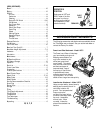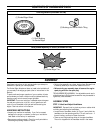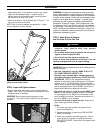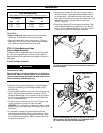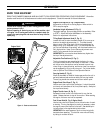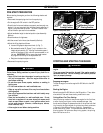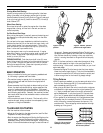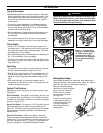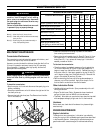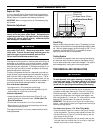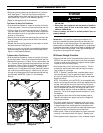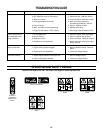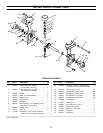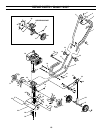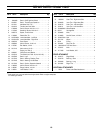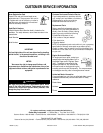
15
• Slide one of the long bushings (provided with unit) onto the
shaft. See Figure 17. Insert the ring lock pin through the
rounded side of the tine shaft and snap the ring down over the
shaft (see DETAIL, Figure 4, in the Assembly Section).
• Repeat on the opposite side of the machine.
Tine Pattern for Stony Soil Conditions:
• Prop the machine forward so it rests on the front of the tubu-
lar carrying handle. The work surface should be flat and firm.
• If tilling in stony soil, remove the ring lock pin (A, Figure 16)
from both sides of the unit. Remove both outer tine sections.
Mark each section as a left or right side tine and whether it is
an inner or outer section.
• Remove the inner tine sections and swap their positions (the
inner right side section goes on the left side of the machine,
and vice versa).
• Reinstall the two outer tine sections on the sides from which
they were removed. See Figure 18.
• Insert the ring lock pins through the rounded side of the tine
shafts and snap the rings down over the shafts (see DETAIL,
Figure 4, in the Assembly Section).
To Replace Worn Tine Sections:
• Prop the machine forward so it rests on the front of the tubu-
lar carrying handle. The work surface should be flat and firm.
• Remove the ring lock pin (A, Figure 16) from both sides of the
unit. Remove the old tine sections and replace them with new
tine sections. Refer to Figure 16 and the tine pattern shown in
the Parts List for tine positioning details. (The tines are ex-
cessively worn if tilling takes much longer than before and the
soil is not being mixed thoroughly.) Insert the ring lock pins
through the rounded side of the tine shafts and snap the ring
over the shaft (see DETAIL, Figure 4, in the Assembly
Section).
IMPORTANT: It is important to prevent gum deposits from
forming in essential fuel system parts such as carburetor, fuel
filter, fuel hose, or tank during storage. Also, experience indi-
cates that alcohol-blended fuels (called gasohol or using ethanol
or methanol) can attract moisture which leads to separation and
formation of acids during storage. Acidic gas can damage the
fuel system of an engine while in storage.
Off-Season Storage Procedure
• Drain the fuel tank of all of the gasoline/two-cycle oil mixture.
NOTE: Do not use a fuel mixture that is older than one season
in order to avoid varnish deposits throughout the fuel system.
Dispose of the fuel mixture properly.
• Start engine and run until fuel mixture is used up. This will
prevent poor performance from stale fuel when your equip-
ment is taken out of storage.
NOTE: If “Gasohol” has been used, complete above instruc-
tions and then put 1/2 pint of gasoline properly mixed with
two-cycle oil (see Fuel Mixing Chart) into fuel tank and repeat
above instructions.
NOTE: Fuel stabilizer (such as STA-BIL) is an acceptable alter-
native in minimizing the formation of fuel gum deposits during
storage. Add stabilizer to the fuel mixture in the fuel tank or
the fuel storage container. Always follow the mix ratio instruc-
tions on the stabilizer container. Run engine at least 10 min-
utes after adding stabilizer to allow the stabilizer to reach the
carburetor. Do not drain the gas tank and carburetor if using
fuel stabilizer.
• Let engine cool down after fuel mixture has been used up.
Clean dirt and debris from engine cooling fins, linkage and
other engine surfaces.
• Pull starter handle slowly until resistance is felt due to com-
pression pressure, then stop. Release starter tension slowly
to prevent engine from reversing due to compression pres-
sure. This position will close both the intake and exhaust ports
to prevent corrosion of the piston and cylinder bore.
• Remove tines. Clean all soil and debris from dust covers and
tine shaft. Lubricate tine shaft with light oil. Replace tines.
• Cover engine and store equipment in a dry, sheltered location.
MAINTENANCE/SERVICE
Figure 16: Remove ring lock pin (A) to take off tines.
Figure 17: Narrow tilling tine
configuration.
Figure 18: Stony soil tine
configuration.
A
STORAGE
• Never store your equipment when there is a fuel mixture in
the fuel tank.
• Never place your equipment near any source of sparks or
open flame (such as from a hot water heater, a space
heater or clothes dryer).
Failure to comply can result in serious personal injury or
property damage.
WARNING



